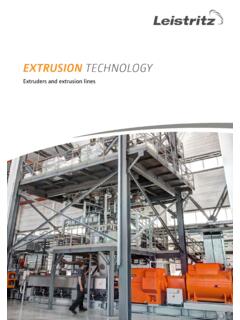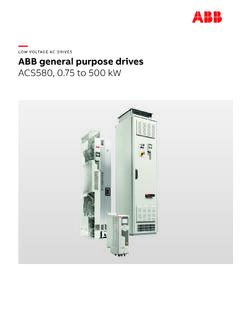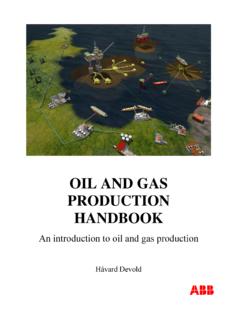Transcription of MASTERBATCH PRODUCTION - Leistritz
1 MASTERBATCH PRODUCTIONE xtruders and extrusion lines23 LeistritzExtrusion TechnologyMASTERBATCH THE GRAIN MAKES THE DIFFERENCE OverviewPlastic pellets with a high share of pigments and/or addi-tives that is much greater than in the final application are called masterbatches. In later process steps such as injec-tion molding, film or fiber PRODUCTION , these are added to the raw polymer to color this or to specifically change other to pastes, powders or liquid additives, the use of a MASTERBATCH improves the process reliability on account of the precisely defined share of pigments in individual pellets.
2 A further advantage is that the mas-terbatch is very easy to process because it does away with the handling of large amounts of powder. It's use is also beneficial from the point of view of environmental impacts and workplace pollution. Small, but with a major impactRaw polymer> 10% organic pigments inorganic pigments effect pigments mono preparations thermal stabilizers light stabilizers flame retardants anti-static agents anti-blocking agents nucleating agents filler reinforcing agent 20-90% Important: the correct dispersionThe goal when manufacturing masterbatches is the optimum dispersion and dis-tribution of the additives in the polymer matrix.
3 This is carried out after wetting by the mechanical energy introduced by the screws. If this takes place too early in the process, the un-moistened pigments can be compressed back into agglomerates by the force exerted on them (cold agglomeration). Two processes can be used to produce a MASTERBATCH : premix* and split-feed**.*see P. 8/9 ** see P. 10/11 Dispersing agentPrimary particlePigmentsAdditivesFillersCompound ingONE GENERALLY DISTINGUISHES BETWEEN THREE MB GROUPS: Color MASTERBATCH is used to color plastic products Additive MASTERBATCH ensures certain chemical and physical properties of the final products ( UV-stabilization, flame-retardant, anti-static) Filler MASTERBATCH contains a high share of fillers such as CaCO OverviewRaw polymerMasterbatchInjection moldingFilm extrusionFiber extrusionProfile extrusionTube extrusionMixing (Homogenization of the mixture) Dosing (constant addition over time in the continuous extrusion process)Wetting (bonding of the pigment particles to the matrix without compacting this)
4 Dispersion (dispersion of the agglomerates in a plasticized state, introduction of the dispersion energy)DistributionStabilization (prevents re-agglomeration)Beispiel einer kundenspezifischen Anlage45 LeistritzExtrusion TechnologyColor masterbatches can be divided up into roughly the following types: Mono batches or "Single Pigment Concentrates" (SPC): Masterbatches from a certain pigment and a supporting base; wax and/or dispersing agents are often added Customized masterbatches: bespoke formulations, mixtures of various powder pigments Custom Coloring: mixture of different SPC granules to produce precisely the color the customer wantsThe main benefit for manufacturers by using co-rotating twin screw extruders is the very good quality of dispersion.
5 This is the basis for a high quality MASTERBATCH . The two co-rotating screws that engage with each other produce a self-clean-ing effect. This allows fast cleaning and consequently a more rapid change of product. Another advantage of co-rotating twin screw extruders is the modular design of the screws and barrels, which, depending on the process, enables a fast set-up and conversion of the processing MASTERBATCH ApplicationsKnowledge of the right color Example of a MASTERBATCH system Applications The ZSE MAXX twin screw extruder from Leistritz is at the heart of hundreds of systems worldwide. The products manufactured with this satisfy even the highest quality demands.
6 Color masterbatches largely consist of individual color pigments that are combined to produce a specific target color. Other components may include effect pigments, dispersing agents and additives. Their PRODUCTION places great demands on the dispersion process because raw materials with different properties have to be optimally incorporated in only one process step. What is crucial here is a knowledge of the properties of the pigments used (coloristics) and great expertise with respect to the extruder's process parameters. Particle sizeParticle shapeMigration resistanceProcessibilityRecommended misometric+more dispersion energy needed, difficult to dispersePremix and split-feed* possible1 20 misometric++little shearing, easy to disperse, sometimes abrasivePremix and split-feed* possible2 180 mPlateletsno datasensitive to shearing lowest possible shearing forces, highest possible mixing effectSplit-feed*very different.
7 From very small to largedepending on pigmentdepending on pigmentfully dispersed, hardly any shearing needed, fuse and distributeOrganicpigmentsInorganicpigmen tsMono preparationsEffect pigmentsThe loading concentration* for inorganic fillers ranges from 40 - 8 % by weight, and for organic pigments from 30 - 60 % by weight.*The maximum load depends amongst other things on the application and base masterbatches can be used in a wide variety of applications. They can be used to modify the physi-cal and chemical properties of plastics , the UV- or flame-resistance, thermal stability or impact strength. The polymer is hereby enriched with large amounts of liquid or powder additives with a low bulk density such as silicate are usually added by means of one or two side stuffers for incorporation.
8 The lower-cut screws in the Leistritz LSB XX side stuffer also help the feed of the material. The high free volume of the ZSE MAXX twin screw extruder (OD/ID = ) means that there is enough space in the process chamber to ensure a good dispersion and high throughput. The additive feed often poses a challenge in process-ing: if additives with a low melting point are added, they could already melt in the side stuffer. This would lead to a blockage in the side stuffer. The formulation consis-tency can then no longer be guaranteed. In such cases, the use of a side stuffer with cooled barrels and screws ( Leistritz LSB XX side stuffer*) is recommended.
9 IMPORTANT PARAMETERS FOR THE RESIDENCE TIMEOn account of different viscosities and in some cases dif-ficult mixtures, the residence time has to be increased for certain formulations. This is achieved by extending the processing unit the use of reverse screw elements*see accessory units P. 13 Extrusion TechnologyLeistritz ApplicationsADDITIVE MASTERBATCHO ptimization of properties ApplicationsHighly-filled masterbatches contain more than 50 % by weight of fillers that are dispersed in a polymer matrix. Different process set-ups are possible depending on the type and amount of filler. The most common fillers include calcium carbon-ate or talcum.
10 Filler masterbatches are primarily used to optimize and increase the stiffness, reduce shrinkage and improve the surface appearance of the final example:CaCO (70 85%) in polyolefinThere are two main reasons why CaCO is used in plastic: it acts as a functional filler or mineral modifier ( to produce breathable films) or it is used to reduce the costs of the compound. What is important when using CaCO is its very good incorporation in the polymer matrix. Coated CaCO types are the most suitable because the surface coating adjusts the surface tension of the mineral to that of the polymer, greatly facilitating its incorporation and dispersion.






